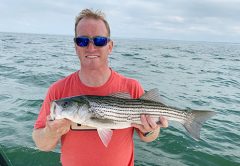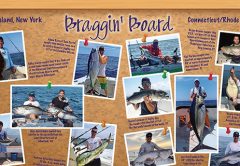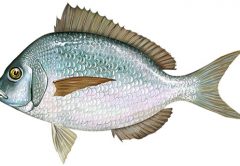T he fact is, many would-be fluke fanatics fail to engage with that undertaking because it’s hard-wired in their minds that fluking is something you do only during lulls in the striper or tuna fishing. They make long drifts, content to pick through endless shorts, fish sloppy baits they never check, lose focus early and often—in short, fail to give the quest the time or energy it warrants. The following points are meant to be a quick crash course in targeting plus-size slabs—something you ought to try before you dismiss it as lesser sport.
The One-Bite Mentality
I can’t deny that you’ll catch some bigger specimens working areas that are seemingly tiled with rats. People who have traditionally gone fluking as a fall-back to other higher angling pursuits seem to need immediate action to justify the effort. IN reality, the best way to target and land a slab over 10 pounds is to shed the need for action—to fish difficult, tideswept, broken-bottom areas, ready to lose numerous rigs or weed up constantly, all in the name of one or two shots at fish over a five-hour span. This means avoiding the rest of the fleet, and often making short, controlled drifts or even power-drifting around boulder-fields, kelp forests, drop-offs, or on the outskirts of deep-water wrecks and rockpiles. You need to redefine successful fluking in terms of two bites and one fish for a full tide trying.
Show ‘Em What They Want
Unlike their cousins, the winter flounder, fluke are active predators with sharp eyesight, and if you want to catch the big ones, you have to play to their feeding preferences. They’re designed for ambush feeding, but will gladly stalk favored food, part of the reason you need to rig baits carefully to produce a convincing natural action, and keep those baits moving along just right. I long told customers on decks I ran that they should think of their strip baits more as lures than as chunks of meat, since fluke would bite or ignore based on the visual appeal. ON a related note, it’s critical to check baits constantly for even the smallest tendrils of weed, which will kill your odds completely.
Slab Structures
For reasons we needn’t understand, big fish will gravitate toward specific micro structures day after day; when you remove one good one, another will fill in shortly thereafter. Such spots are worth committing to memory, as they may give you a dozen mega-slabs over the course of a season. And just as much as monster bass will hang on specific parts of certain sunken structures, big fluke will congregate in tight areas. A huge mistake folks make is catching a decent fish or two on long, aimless drifts, then repeating them, squandering big chunks of tide on marginal bottom. Instead, make short, precise passes over prime spots, repeating until the fish catch on; then move a bit off the original track and make other passes nearby. Just as in striper fishing, the tide’s always a-wastin’.
Expand Your Arsenal
I’ve read—and written—plenty of articles on specific big-fluke methods like drifting giant strip baits. What you really want is to master several odds-on methods (bucktailing, live bait, and strip-baits) each of which has a time and place—and not one of which catches doormats in every situation. Pay close attention to your rigging, avoiding needless hardware, spacing sinkers/hooks/jigs properly. The three aforementioned approaches to doormat fishing each offer distinct advantages, challenges, and limitations, and each require practice. With big strip baits, for example, the idea is to feed them carefully, giving line, letting them eat; with live-bait, big slabs hit like a Greyhound Bus—fast and hard—and you generally only get one quick chance to set the hook.
Prepare to Sacrifice
If you’re serious enough about cracking the 10-pound mark, you need to be prepared to move far off the beaten path, hitting the little areas where gravel meets rubble, kelp and old lost lobster gear. Especially during the scouting phase, while you learn the lay of the bottom—which parts will produce, which are unfishably jammed up—brace yourself to lose quite a bit of terminal tackle. When you’re heading for broken real estate, tie up tons of rigs and get ready to break off—it’s all part of the search for doormat mecca. One friend of mine pries a handful of monster fluke off areas better known for cod or sea bass production each season. Because these are deep-water areas (120 to 140 feet), they also tend to have intermittent dogfish issues. You may find that the dogs overrun you at certain times of year or under certain conditions, but also learn that there are times when you can fish successfully through the dogfish by minimizing “bling” in your rigging and, again, by accepting that you’ll probably burn through some rigs to get to the 12-pound welcome mat you’re after.
Learn Conditions
Drift conditions are the name of the game in any fluking, trophy hunting in particular. You need to learn which combinations of wind and tide turn certain areas on, which do the opposite. To some extent, you may be able to compensate for wrong-direction (i.e. into-the-tide) drifting through some throttle work. In the bigger picture, scouting diverse areas that are subject to different tide or wind influences will give you all-important options, and let you time your energies most effectively—avoiding the fishless scenarios, or simply salvaging a day when some of your prime areas have been rendered off-limits by weather.
Hyper-Focus
Ridiculous as it sounds, one of the biggest pitfalls in all of fluking—at no point more so than in monster fishing—is the human tendency to get bored, distracted, or otherwise disengaged to the point that you miss important cues from the bottom, your gear, or your quarry. It’s no cinch, but you’ll do wonders for your slab-seeking odds when you train yourself to fish with absolute focus, ready at any time for the bite, even when the fishing’s dead and every grain of your being wants you to lapse into the old middle-distance stare. Pay attention, pay attention, pay attention.
One additional trick that has accounted for some of my career-best fluke: If you’re really hard-up to catch a welcome-mat-sized summer flattie, plan to fish the days of major fluke tournaments but do not enter the events. If you want to explore a new chapter of Murphy’s Statute, don’t enter that tournament and devote the day to sticking a slab of true substance. I have—swear to God—landed three fish during tournaments that would have taken first place in tournaments I hadn’t entered.










